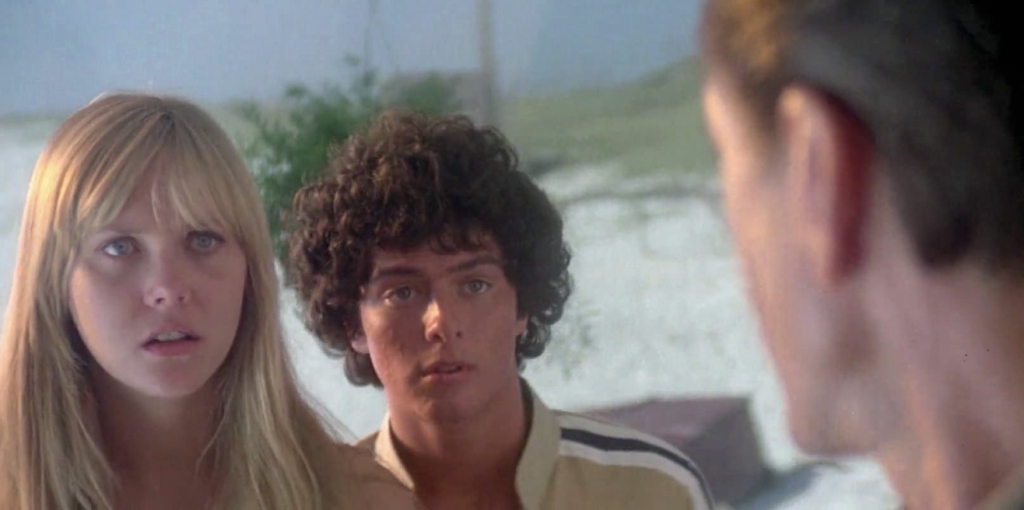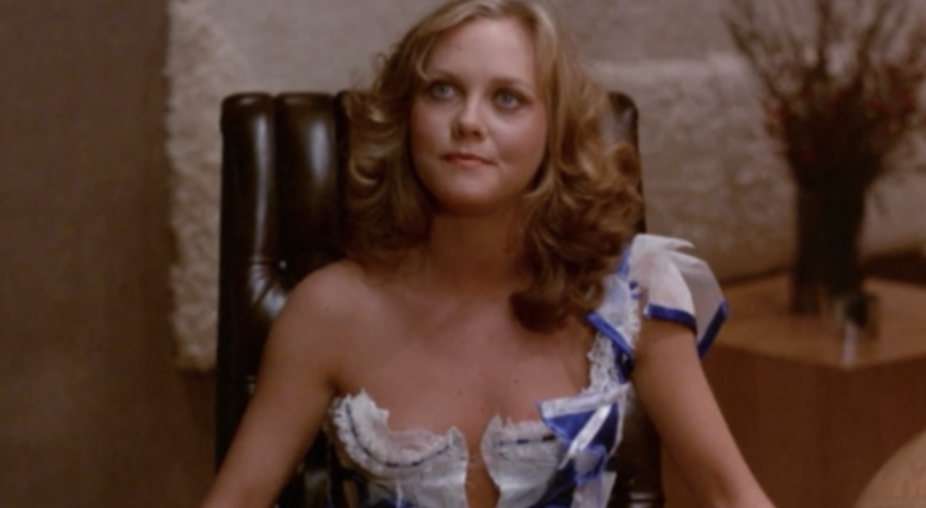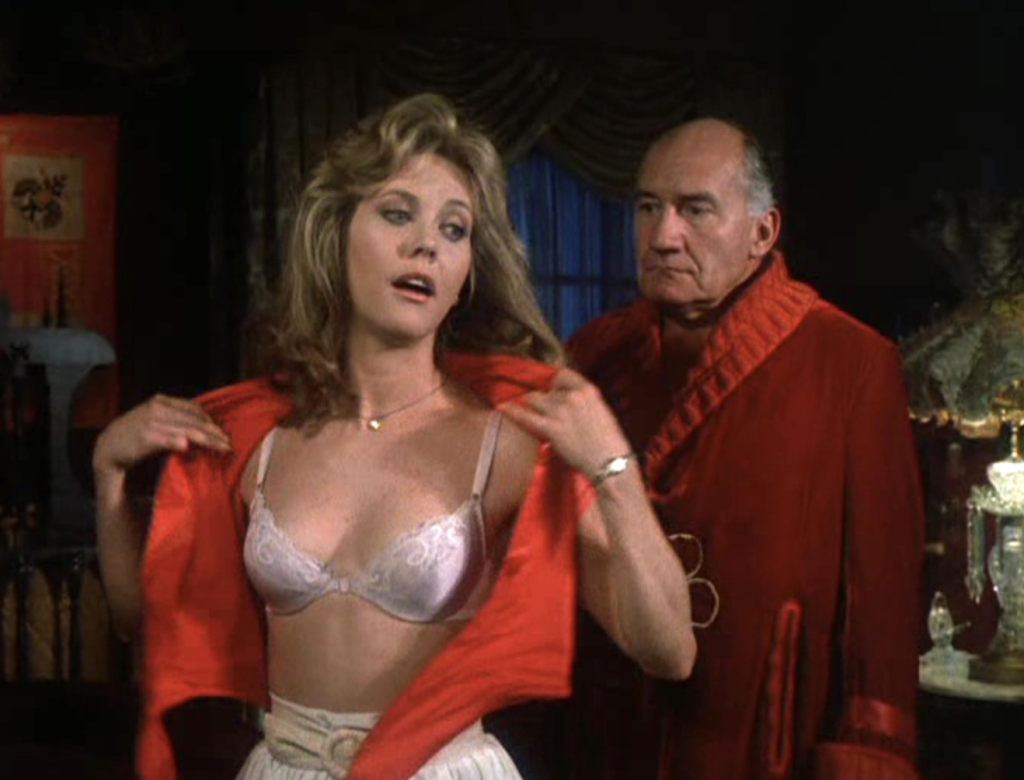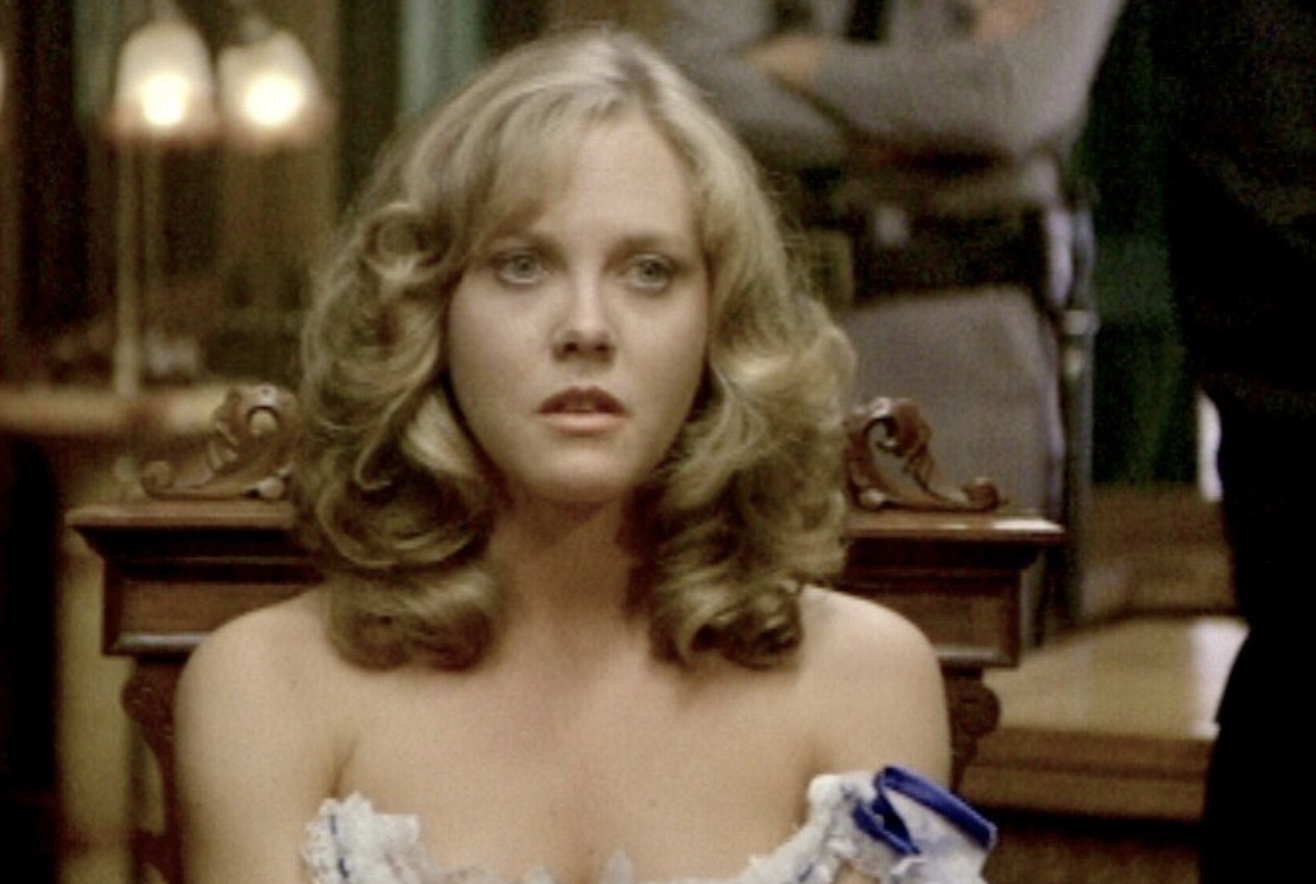Picture it: 1978. A boat rocking in some fake ocean, plastic fin pushing through the water like an ex-wife with a lawyer in tow. And clinging to the side, wide-eyed and drenched, is Ann Dusenberry. She was playing Tina Wilcox, the nice little pageant girl in Jaws 2. The one who screamed her lungs out and somehow survived the mechanical bastard they called a shark. She screamed well. That’s what people remembered. That scream had more truth in it than the script.
But the story didn’t end with her outswimming some rubber Great White. That was just the hook. After that, she stumbled into the messy circus called Hollywood – late ’70s, early ’80s – the kind of place where dreams come with strings attached, booze on the table, and directors who can’t make it through a weekend without collapsing.
She fought fake sharks, sure. She also stood toe-to-toe with real actors – Scheider, Nolte, Bridges – men with names carved into the wood of the business. Hell, she even sparred with Lucille Ball, comedy’s old warhorse herself. She wasn’t a superstar, never plastered on billboards like Farrah’s smile or Jane Fonda’s legs, but she kept showing up and was arguably cute than both. Different sets, different scripts, different hustles. She played it straight, funny, tragic – whatever the circus demanded.
Ann Dusenberry’s film career wasn’t the kind they build statues for. But it was full of odd turns and surprises.
Early Ambitions and a Hollywood Break
Ann’s path to Hollywood had a bit of an old-school twist. Born in Tucson, Arizona in 1953, she always knew she wanted to perform. She studied theater arts in college (even focusing on musical theater – this was a young woman with Broadway dreams). But sunny Broadway aspirations soon turned into a very crafty Hollywood plan. Ann leveraged a family friend’s job at Universal Studios – her boyfriend at the time was a truck driver on the lot – to get her foot in the door. In a move that sounds like a movie plot itself, she slipped her resume and headshot into Universal’s internal mail system, addressed to casting folks and producers. Imagine the surprise of some executive opening an envelope and essentially getting an unsolicited audition via snail mail! Yet it worked. Her bold tactic led to a meeting, and ultimately Ann signed a seven-year contract with Universal Studios. In the late 1970s, that made her one of the last actresses to come up under the old studio contract system – a throwback to the golden age of Hollywood where studios kept stables of actors on payroll.
With a Universal contract in hand, Ann began landing small roles to prove her mettle. She made her film debut in 1975’s action drama White Line Fever, in a blink-and-you-miss-it part as a barmaid. It wasn’t glamorous, but it was a start. She also popped up on popular TV shows of the era – little one-off parts on Emergency!, McCloud, The Six Million Dollar Man – the kind of gigs that helped a young actress learn the ropes. Every role, no matter how small, was laying the groundwork. But her big break was just around the corner, lurking in the water…
By 1977, Universal was gearing up to film Jaws 2, the sequel to Steven Spielberg’s 1975 blockbuster about a certain finned menace. The sequel needed a cast of fresh-faced teens to terrorize (the shark’s primary menu in the film). Thanks to her contract, Ann Dusenberry was one of the first actors cast in Jaws 2, snagging the role of Tina Wilcox – a character lovingly nicknamed “Miss Amity” for being the town’s reigning beauty queen. At 24 years old, Ann was about to be thrown into the deep end (literally and figuratively) of a major studio production.
Ironically, when the offer came, Ann wasn’t entirely thrilled at first. Jaws 2 was set to shoot on location in Florida, which meant months away from her home in Los Angeles. As a young actress under contract, she didn’t have much choice in the matter, and initially the idea of relocating for a long shoot gave her pause. But hey, when Universal says “We have a role for you in the Jaws sequel,” you pack your bags and pack your shark repellent, right? Little did she know that this reluctant journey would become the defining role of her career.
Landing the Role of “Miss Amity” in Jaws 2
Stepping into Tina Wilcox’s shoes (or rather, her flip-flops) in Jaws 2 was a major opportunity for Ann – and it came with its share of behind-the-scenes drama. The production of Jaws 2 infamously hit some rough waters early on. The original director, John D. Hancock, was fired after a short time filming, as the studio wasn’t happy with the direction he was taking. Production ground to a halt while Universal scrambled to find a new director. Imagine being a young actor on your first big film, only to have the entire shoot suddenly up in the air! Many of the actors playing the teens in Jaws 2 flew back to California during this hiatus, unsure if they’d still have jobs when the dust settled. Ann was among them – and rather than sit around anxiously, she hosted a backyard cookout for several of her castmates. One can picture this surreal scene: a bunch of Hollywood hopefuls grilling hot dogs and trying to play it cool, all the while wondering if the shark movie was going to sink or swim.
After a tense wait, the phone calls finally came. The studio had hired a new director, Jeannot Szwarc, to right the ship (or boat, in this case). The good news: the project was back on, and Ann was still Tina Wilcox. In fact, there was a silver lining to all the turmoil. During the production reboot, the script underwent changes and Tina’s role was expanded. Ann found herself with more scenes and screen time than originally planned. In a true Hollywood twist, chaos had led to a better part! When Jaws 2 eventually hit theaters in the summer of 1978, Ann Dusenberry received co-star billing in the credits – a testament to how prominent Tina had become in the final cut. Not bad for someone who initially had “no interest” in spending the summer on a shark-infested set.
Once filming resumed, Ann threw herself into portraying Tina, the quintessential Amity Island teenage girl. Tina Wilcox is introduced as the all-American good girl – playful, friendly, and just a bit of a worrywart (with good reason, as it turns out). As “Miss Amity,” she’s something of a hometown sweetheart, and Ann’s natural warmth made that shine through. In early scenes, Tina goofs around with her boyfriend Eddie and their friends, sailing and water-skiing in the sunny paradise of Amity. She’s the type of character you can’t help but like – the responsible teen who double-checks the gas tank and frets if someone gets too close to the fire (figuratively speaking). Ann reportedly even had Tina wear a small “Miss Amity” banner in a town event scene (a little touch that speaks to the character’s local celeb status). It was a far cry from the fear to come, but those light-hearted moments made Tina feel like a real person rather than just shark bait.
Of course, this being a Jaws movie, the idyllic teen hangouts don’t last. When the great white returns for its sequel buffet, poor Tina goes through the wringer. In one of Jaws 2’s most memorable sequences, Tina and Eddie are enjoying a romantic boat ride (on a vessel aptly named Tina’s Joy – oh, the irony) when terror strikes. The shark attacks their boat with sudden fury. In the chaos, Eddie is thrown into the water and meets a grisly fate as Tina watches in horror. Ann’s performance in this scene is heart-wrenching; her joyous demeanor shatters into raw panic and grief as Tina realizes her boyfriend is gone. Stranded on a wrecked boat, completely alone, Tina is next seen by Chief Brody and his wife, who come upon her vessel. Ann plays Tina as utterly shell-shocked – she’s hiding under the boat’s seats, trembling uncontrollably. When she finally musters the strength to leap into Ellen Brody’s arms, she can barely speak. But then Tina delivers the line that confirms everyone’s worst fears: in a blood-curdling scream that echoes over the waves, she cries, “Shark! There’s a shark out there!” That moment, powered by Ann’s full-throttle scream, is a turning point in the film – it’s the instant Brody (and the audience) know that the nightmare is real and raging anew.
For a young actress, carrying such an intense scene was no small feat. Ann managed to capture genuine terror and trauma, giving Jaws 2 one of its emotional high points. She took Tina from a carefree, giggly teen to a traumatized survivor, and made us believe every step of that journey. By the end of the movie, Tina is one of the few teen characters who actually lives to see another day (most of the other kids spend the climax stranded at sea until Brody saves them, but they’re mostly battered and silent). In the final scenes, as rescue arrives, you can spot Tina in shock, wrapped in a blanket – a haunting image of innocence lost.
Ann Dusenberry’s portrayal of Tina Wilcox left a lasting impression on Jaws fans. Jaws 2 itself chomped a sizable chunk out of the box office in 1978 – it was a hit, proving that audiences were still hungry for more shark mayhem. And among that ensemble of teen actors, Ann stood out. Tina was memorable, in part because Ann gave her such heart (and lungs, given that scream!). To this day, devotees of the Jaws franchise remember “Miss Amity” with fondness. Ann has even been invited to fan events and documentary interviews to reminisce about her Jaws 2 experience decades later. It’s safe to say that facing down a killer shark on the big screen gave Ann’s career a terrific boost. After all, once you’ve survived a giant shark attack in Hollywood, you can survive just about anything.

Life After Amity: Little Women and More (1978–1979)
So what do you do after you’ve been menaced by a monstrous fish and lived to tell the tale? If you’re Ann Dusenberry, you pivot to something completely different. Riding the wave of Jaws 2’s success, Ann took on a role in late 1978 that couldn’t have been more removed from bloody saltwater action. She was cast as Amy March in a television miniseries adaptation of Little Women, based on Louisa May Alcott’s beloved novel. Talk about a change of pace! One minute Ann was in a wetsuit, the next she was in a 19th-century hoop skirt. In Little Women, she portrayed the youngest of the March sisters – Amy, the artistic, somewhat spoiled, yet ultimately big-hearted girl who grows from bratty teenager to elegant young lady. For Ann, this role was a chance to show her classical acting chops in a wholesome period piece. No screams or sharks here, just drawing rooms, bonnets, and sisterly bonding.
The Little Women miniseries boasted a noteworthy cast. Ann co-starred alongside Jessica Harper (cult film fans know her from Suspiria and Phantom of the Paradise) who played Jo March, and Eve Plumb (forever remembered as Jan Brady from The Brady Bunch) as Beth. The project aired on NBC and offered a cozy, family-friendly showcase. Ann fit right in as Amy; she brought a youthful spunk to the character, nailing Amy’s transition from mischievous girl who burns her sister’s manuscript (oh, Amy…) to a mature young woman who wins Laurie’s heart in the end. If audiences had any lingering image of Ann as panicked Tina, her turn as Amy March surely replaced it with visions of Victorian poise.
The miniseries was well-received enough that NBC attempted to spin it off into a regular television series the following year. Ann reprised her role in this Little Women series in 1979, once again donning her petticoats. Unfortunately, lightning didn’t strike twice – the series was short-lived, lasting only four episodes before cancellation. Perhaps 1970s viewers weren’t clamoring for weekly Alcott family adventures. (Or maybe, without any sharks or high-stakes drama, it was hard to compete for ratings.) Still, despite the show’s quick end, Ann gained valuable experience anchoring a project from start to premature finish. Not every post-blockbuster move pans out, but she demonstrated adaptability and a willingness to explore new territory beyond the surf and sand of Amity Island.
1978 wasn’t all book adaptations for Ann, either. That same year she appeared in a contemporary coming-of-age film titled Goodbye, Franklin High. In this small teen dramedy, Ann played Sharon, the supportive girlfriend of a high school senior who is trying to figure out his future (college, baseball career, or the unknown beyond?). The film is a slice-of-life look at late-70s youth, the kind of earnest story about saying farewell to adolescence. Ann’s role gave her yet another facet to explore – the everyday modern teenager – no life-or-death stakes, no period costumes, just a regular girl in the ’70s dealing with life and love. While Goodbye, Franklin High didn’t make a huge splash, it added to Ann’s growing repertoire of genres. By the end of the 1970s, in just a short span, she had done horror/thriller (Jaws 2), historical drama (Little Women), and a present-day youth film. Not to mention she kept one foot in TV with guest appearances on series and TV movies. It was an eclectic start that set the stage for an interesting run through the 1980s.

Hollywood in the ’80s: Drama, Thrills, and Laughter
If Ann Dusenberry’s late ’70s roles were varied, her 1980s career took diversity to a new level. She spent the decade popping up all over the genre map, holding her own alongside some of Hollywood’s notable talents. It seems Ann was game to try just about anything – a quality that kept her working steadily even if she never again had a role as high-profile as Jaws 2. Let’s take a tour through some of her film highlights of the ’80s:
In 1980, Ann appeared in Heart Beat, a romantic drama about the Beat Generation. This film explores the tangled relationships between real-life literary figures Jack Kerouac, Neal Cassady, and Carolyn Cassady. Ann had a supporting role as a character named Stevie. Now, Heart Beat may not ring a bell for many – it was a modest film – but the cast was top-tier: Nick Nolte as Neal Cassady, Sissy Spacek as Carolyn, and John Heard as Kerouac. Ann found herself in excellent company, acting in scenes with Oscar-caliber performers. Heart Beat gave her a chance to dip into a dramatic, character-driven narrative far removed from the popcorn thrills of Jaws 2. As Stevie, she added a bit of fictionalized emotional texture to the story of these Beat icons. While the movie wasn’t a box-office hit (in fact, it underperformed), for Ann it was a meaningful experience to share the screen with such respected actors. It signaled that she wasn’t confined to horror or light fare; she could slide into a serious drama and hold her own.
The following year, 1981, brought Ann into the realm of mystery and suspense with Cutter’s Way. This film – a neo-noir thriller originally titled Cutter and Bone – has since become a cult classic, known for its moody atmosphere and sharp performances. It starred Jeff Bridges as a laid-back gigolo and John Heard (fresh off Heart Beat, interestingly) as a disabled Vietnam vet, both of whom get wrapped up in investigating a possible murder involving a powerful businessman. Ann Dusenberry took on the role of Valerie Duran, the sister of the murder victim at the heart of the story. Valerie comes into play as Bridges’ and Heard’s characters try to piece together what happened to her brother. It’s a smaller role, but an important one: Valerie’s desperation for justice helps drive the plot. Ann brought a convincing sincerity to Valerie, making you feel her grief and resolve even with limited screen time. Acting alongside Jeff Bridges can be intimidating for some, but Ann slipped into the ensemble comfortably. Cutter’s Way didn’t get its due in 1981 (it flopped commercially), but critics praised it, and over the years it’s been re-evaluated as one of the underrated gems of that era. For Ann, being part of a high-quality thriller like this further proved her versatility. She went from victim in a thriller (Jaws 2) to playing a victim’s family member seeking answers in a thriller – a nice little inversion of roles.
After those dramatic turns, Ann decided to have some fun. Enter the world of 1980s comedy. In 1982, she participated in National Lampoon’s Movie Madness. Now, if you haven’t heard of this one, don’t worry – it’s a rather obscure entry even among National Lampoon’s films. Movie Madness was an anthology-style comedy composed of three satirical vignettes. Ann appears in the segment titled “Success Wanters,” playing a character with the fabulously alliterative name Dominique Corsaire. The story is a cheeky send-up of rags-to-riches tropes, and Ann’s Dominique is at the center of the absurdity. The movie itself had a troubled release (it was actually filmed in 1981 but didn’t really see the light of day until later due to negative previews). It’s no Animal House, that’s for sure. However, for Ann, it was a chance to cut loose and do something zany. She got to play up a comedic persona, proving that her talents weren’t limited to straight drama or screaming at sharks. Even though Movie Madness is largely forgotten, it adds yet another flavor to Ann Dusenberry’s filmography: out-and-out spoof comedy.
Continuing her tour of just about every genre, Ann next dove into the thriller genre in a bigger way. In 1983, she starred in a film called Lies. This was a twisty mystery/thriller directed by the Wheat brothers (known for some cult horror writing). In Lies, Ann took on the leading role of an actress named Robyn Wallace. The plot is a bit complicated (as many 80s thrillers are), but essentially Robyn is hired to impersonate a rich man’s institutionalized wife as part of an elaborate con – only to have things go dangerously awry. It’s the kind of role that required Ann to be on screen a lot, carrying the narrative as it ping-pongs between Hollywood sets and a mental asylum, blending make-believe and reality. Acting opposite her were industry veterans like Bruce Davison and Hoyt Axton. While Lies didn’t become a mainstream hit, it’s noteworthy because it put Ann in the driver’s seat. After several years of supporting parts, here she was the central character, appearing in virtually every scene and really showcasing her range – from feigning confidence as a decoy socialite to conveying fear when the scheme unravels. If one were to pick a film that gave Ann Dusenberry a chance to show she could lead a movie, Lies would be it.
And then, as if to make sure no genre stone was left unturned, Ann went for full broad comedy with 1985’s Basic Training. Brace yourself for this plot: A young, attractive woman goes to work at the Pentagon and, disgusted by the rampant sexual harassment, decides to get revenge by using her own charms and smarts to outwit the bumbling male brass. That young woman is played by Ann, in the role of Melinda. Basic Training (also released under the naughty title Up the Military) is a sex farce very much of its time – think Police Academy meets Porky’s, but set in a government office. Ann’s character pretends to seduce a series of lecherous officials as a way to manipulate them into, believe it or not, approving a peace plan and exposing incompetence. The tone is over-the-top silly, complete with scantily clad shenanigans and goofy gags. For Ann, this must have been a wild departure from everything she’d done before. She gamely throws herself into the comedic chaos, whether it’s fending off unwanted advances with a smile or tricking the bad guys with a wink. There’s even a scene where Melinda (disguised in lingerie) fools a Soviet general – it’s that kind of movie. Critics absolutely hated it (it regularly makes lists of the worst films of 1985), but if you’re in the right mood, Basic Training can be a so-bad-it’s-good hoot. Importantly, it gave Ann a starring vehicle in a comedy. Not many actresses get to say they’ve anchored a military sex comedy, for better or worse! And you’ve got to admire her courage in taking on something so irreverent. She likely figured, why not try a little slapstick and see what happens? At the very least, it showed Hollywood casting agents that she wasn’t afraid to tackle lighter fare and even make a fool of herself for a laugh.

By the mid-80s, Ann was a familiar face, even if the projects she was in weren’t blockbusters. In 1986, she appeared in The Men’s Club, a dramatic ensemble film based on a novel about a group of male friends (mostly middle-aged professionals) who gather for an intense night of soul-searching and emotional unburdening. This movie featured a roster of well-known actors: Roy Scheider (with whom Ann had worked in Jaws 2, of course), Harvey Keitel, Frank Langella, Treat Williams, among others. Ann played a character named Page, who comes into the story as one of the women the men encounter during their nocturnal odyssey. Without going into R-rated detail, let’s just say The Men’s Clubexplores themes of marriage, fidelity, and midlife crisis, and some of the men seek comfort from younger women. Ann’s role gave her a chance to share scenes with Roy Scheider again – a little mini-Jaws 2 reunion on screen. This time there were no sharks in sight, just a lot of frank dialogue. The film itself received mixed reviews (some found it insightful, others thought it was clichéd), but it was a respectable project and one more instance of Ann working alongside heavyweight co-stars.
Amidst these film projects, Ann also kept one foot in television throughout the 1980s. One especially notable TV role came in 1986, the same year as The Men’s Club. Ann was cast in the ABC sitcom Life with Lucy – and this was a big dealbecause the “Lucy” in question was Lucille Ball, the comedy legend herself. Lucille Ball was making a comeback to TV (at the spry age of 75!) and Ann Dusenberry landed the role of Lucy’s daughter (technically, the character was the daughter of Lucy’s character, who was a grandmother on the show). Imagine: you go from working with a mechanical shark to working with the most famous redhead in comedy history. On Life with Lucy, Ann played Margo, a sensible mother of two, often reacting in a befuddled way to her zany mother (Lucille Ball, of course) and trying to keep the peace. It was a classic setup of uptight daughter vs. wacky mom. Getting to act opposite Lucille Ball must have been both thrilling and nerve-wracking, but by all accounts Ann handled it with grace and good humor. Sadly, Life with Lucy was short-lived – it was canceled after only 8 episodes aired (the show struggled in ratings and was pulled, marking an end to Lucy’s TV career). Still, Ann checked off a bucket-list item that few actors can claim: sharing the screen with the one and only Lucy. And even though this was on the small screen, it added to the narrative of Ann’s career: she continually found herself in interesting company, be it killer sharks, Oscar winners, or comedy royalty.
By the end of the 1980s, Ann’s film and TV appearances had slowed down a bit. She continued making guest appearances on hit shows like Murder, She Wrote, Magnum, P.I., and Designing Women. Her last notable film role of that era was in Play Nice (1992), a crime thriller where she co-starred as a detective’s wife embroiled in a serial killer investigation. After that, having spent nearly 20 years in the industry, Ann Dusenberry made a decision to step away from the Hollywood grind.
Curtain Call and Legacy
In the early 1990s, Ann quietly retired from on-camera acting. Unlike some of her peers, she didn’t make a splashy announcement or headline news; she simply pivoted to other aspects of life. But what’s lovely about Ann’s story is that she never lost her passion for the craft of acting – she just redirected it. She returned to her roots in a way, focusing on stage performances and community theater, where the spotlight might be smaller but the work can be just as fulfilling.
Throughout the ’90s and into the 2000s, Ann Dusenberry graced the stage in various productions. She had a fondness for classic plays – for instance, she took on the role of Mrs. Gibbs in Our Town, bringing her full circle to that small-town feel (only this time without sharks or pageants). She also showed she still had comedic timing in stage farces like Noises Off, where split-second timing and physical comedy are key. In 2021, she was even noted to have appeared in a production of Ripcord, a modern comedy about feisty seniors in a retirement home (proving that as the years go by, Ann isn’t afraid to embrace roles that come with laugh lines – of both kinds).
Outside the theater, Ann built a rich personal life. She married Brad Fiedel in 1993 – if that name sounds vaguely familiar, it’s because he’s a renowned film composer, best known for creating the iconic score to The Terminator and its sequel Terminator 2: Judgment Day. Yes, Ann married the man who gave Arnold Schwarzenegger his musical da-dum da-dum-da-dum theme. They settled in California (not too far from the ocean, interestingly) and raised two daughters together. Ann also pursued higher education later on, earning a master’s degree in marriage and family therapy. For a time, she worked in helping others through counseling – showing that her talents and interests go beyond the spotlight.
But the acting world never fully let go of Ann Dusenberry, and she never fully let go of it. In Santa Barbara, she took on the role of Artistic Director at a local theater conservatory, mentoring young actors and directing stage productions. It seems that storytelling and performance are simply part of her DNA, whether she’s in front of an audience or guiding the next generation from behind the scenes.
Looking back on Ann Dusenberry’s film career, it’s easy to frame it around that one gigantic shark movie – it was the flashiest moment, to be sure. But there’s much more to appreciate when you zoom out. Here’s a woman who navigated the treacherous waters of show business in the ’70s and ’80s with a kind of steady determination. She never became a marquee superstar, but she consistently landed roles across a spectrum of genres, which is its own kind of success. One year she’s America’s sweetheart in peril, the next she’s wearing a bonnet in a literary adaptation, then she’s cracking jokes in a farce, then trading lines with Oscar winners, then yukking it up with Lucy. That flexibility kept her working when others might have been typecast or faded away.
Ann’s journey also reflects the reality of Hollywood for many actors: there are peaks (like a hit sequel) and valleys (like a canceled series), surprise twists (your film’s director gets fired!) and lucky breaks (you meet the right people, you snag the right part). Through it all, Ann maintained a grounded, no-fuss presence. Interviews from later years show she has a good sense of humor about her rollercoaster career – she’s proud of her work, but also the first to chuckle about, say, the campiness of Basic Training or the fact that people still want to talk to her about a movie she made in 1978.
For movie buffs and fans of Jaws 2, Ann Dusenberry will forever be remembered as Tina Wilcox, the girl who survived a shark attack and let out a scream that still rings in our ears. And that’s a pretty cool legacy. Not many actors get to be part of an iconic franchise that stands the test of time. But beyond Amity Island, Ann’s career is also a time capsule of an era in Hollywood when a working actor could hop from genre to genre, building a patchwork of interesting roles. She may not have become a household name, but she certainly made an impact on audiences who encountered her work. Even now, if you rewatch Jaws 2, you’ll likely find yourself rooting for Tina all over again – and appreciating the genuine fear and heart Ann brought to the role. And if you dig a little deeper into those ’80s films, you might just discover a gem or two (or at least get a good laugh at some retro comedy).
Today, Ann Dusenberry seems content with the path she carved. She’s got stories to tell (oh, the behind-the-scenes anecdotes she can share about mechanical sharks malfunctioning or Lucy cracking jokes between takes). She has a loving family and a life in the arts that she shaped on her own terms. In a way, that’s the real happy ending: not just surviving the shark, but thriving beyond it.





